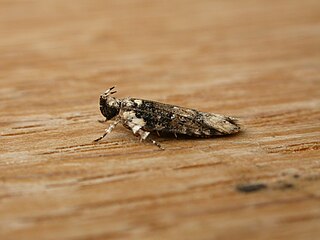Related Research Articles
Pauroneura is a genus of moth in the family Gelechiidae. It contains the species Pauroneura brachysticha, which is found in Australia, where it has been recorded from Queensland.
Xyroptila peltastes is a moth of the family Pterophoridae. It is found in Australia.
Microcolona characta is a moth in the family Elachistidae. It was described by Edward Meyrick in 1897. It is found in New Zealand and Australia, where it has been recorded from New South Wales.
Rhadinophylla siderosema is a moth in the family Gelechiidae. It was described by Turner in 1919. It is found in Australia, where it has been recorded from Queensland. It has also been recorded from Fiji.
Ardozyga cephalota is a species of moth in the family Gelechiidae. It was described by Edward Meyrick in 1904. It is found in Australia, where it has been recorded from Western Australia.
Ardozyga crotalodes is a species of moth in the family Gelechiidae. It was described by Edward Meyrick in 1904. It is found in Australia, where it has been recorded from Queensland.

Ardozyga nyctias is a species of moth in the family Gelechiidae. It was described by Edward Meyrick in 1904. It is found in Australia, where it has been recorded from southern Queensland and New South Wales.
Ardozyga sporodeta is a species of moth in the family Gelechiidae. It was described by Turner in 1919. It is found in Australia, where it has been recorded from Queensland.

Ardozyga sodalisella is a species of moth in the family Gelechiidae. It was described by Francis Walker in 1864. It is found in Australia, where it has been recorded from Queensland and New South Wales.
Ardozyga deltodes is a species of moth in the family Gelechiidae. It was described by Oswald Bertram Lower in 1896. It is found in Australia, where it has been recorded from Victoria and New South Wales.
Xenolechia ceanothiella is a moth of the family Gelechiidae. It is found in North America, where it has been recorded from California.
Stenoma chloroloba is a moth of the family Depressariidae. It is found in Peru, French Guiana, Guyana and Brazil.
Antaeotricha tumens is a moth of the family Depressariidae. It is found in French Guiana.
Hylypnes isosticha is a moth in the family Xyloryctidae. It was described by Edward Meyrick in 1915. It is found in Australia, where it has been recorded in Queensland.
Odites oligectis is a moth in the family Depressariidae. It was described by Edward Meyrick in 1917. It is found in southern India.
Agriophara neoxanta is a moth in the family Depressariidae. It was described by Edward Meyrick in 1915. It is found in New Guinea and Australia, where it has been recorded from Queensland.
Antaeotricha percnogona is a moth in the family Depressariidae. It was described by Edward Meyrick in 1925. It is found in Peru.
Antaeotricha plerotis is a species of moth in the family Depressariidae. It was described by Edward Meyrick in 1925. It is found in Peru.
Antaeotricha lepidocarpa is a moth in the family Depressariidae. It was described by Edward Meyrick in 1930. It is found in Brazil (Para).
Moca aphrodora is a species of moth in the family Immidae first described by Edward Meyrick in 1922. It is found in Brazil and Peru.
References
| This article on a moth of the family Xyloryctidae is a stub. You can help Wikipedia by expanding it. |